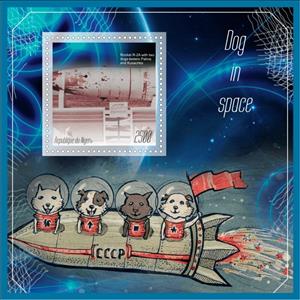Souvenir Sheet: Dogs in Space (Rocket R2-A) (Niger 2016)
Dogs in Space (Rocket R2-A) (Niger 2016)
01 January (Niger ) within release Dogs (2016) goes into circulation Souvenir Sheet Dogs in Space (Rocket R2-A) face value 2,500 West African CFA franc
| Souvenir Sheet Dogs in Space (Rocket R2-A) in catalogues | |
|---|---|
| Colnect codes: | Col: NE 2016-95 |
Souvenir Sheet is square format.
Produced in Moscow, Russia.Also in the issue Dogs (2016):
- Mini Sheet - Dogs Breed of Dogs face value 4*750;
- Mini Sheet - Dogs Breed of Dogs face value 5,500;
- Souvenir Sheet - Dogs Breed of Dogs (German Dog) face value 750;
- Souvenir Sheet - Dogs Breed of Dogs (Jagdterrier) face value 3,000;
- Souvenir Sheet - Dogs Breed of Dogs (Poodle) face value 2,500;
- Souvenir Sheet - Dogs Breed of Dogs (Pug) face value 750;
- Souvenir Sheet - Dogs Breed of Dogs (St. Bernard) face value 750;
- Souvenir Sheet - Dogs Breed of Dogs (Standard Schnauzer) face value 750;
- Mini Sheet - Dogs in Space face value 4*750;
- Mini Sheet - Dogs in Space face value 5,500;
- Souvenir Sheet - Dogs in Space (Dog in the capsule) face value 750;
- Souvenir Sheet - Dogs in Space (Laika dog monument) face value 3,000;
- Souvenir Sheet - Dogs in Space (Laika) face value 750;
- Souvenir Sheet - Dogs in Space (Rocket R2-A) face value 2,500;
- Souvenir Sheet - Dogs in Space (Sputnik 2) face value 750;
- Souvenir Sheet - Dogs in Space (Veterok and Ugolek) face value 750;
- Mini Sheet - Dogs Nordic Dogs face value 4*750;
- Mini Sheet - Dogs Nordic Dogs face value 6,000;
- Souvenir Sheet - Dogs Nordic Dogs (Chukchi husky sled) face value 3,500;
- Souvenir Sheet - Dogs Nordic Dogs (Halley VI) face value 750;
- Souvenir Sheet - Dogs Nordic Dogs (Kamchatka sled dog) face value 750;
- Souvenir Sheet - Dogs Nordic Dogs (Michail Somov) face value 750;
- Souvenir Sheet - Dogs Nordic Dogs (Northern sled dogs) face value 2,500;
- Souvenir Sheet - Dogs Nordic Dogs (Siberian Husky) face value 750;
- Mini Sheet - Dogs Working Firedogs face value 4*750;
- Mini Sheet - Dogs Working Firedogs face value 6,000;
- Souvenir Sheet - Dogs Working Firedogs face value 750;
- Souvenir Sheet - Dogs Working Firedogs face value 750;
- Souvenir Sheet - Dogs Working Firedogs face value 750;
- Souvenir Sheet - Dogs Working Firedogs face value 750;
- Souvenir Sheet - Dogs Working Firedogs face value 2,500;
- Souvenir Sheet - Dogs Working Firedogs face value 3,500;
|
Data entry completed
50%
|
|
|---|---|
| Souvenir Sheet Dogs in Space (Rocket R2-A) in digits | |
| Country: | Niger |
| Date: | 2016-01-01 |
| Emission: | Illegal |
| Format: | Souvenir Sheet |
| Face Value: | 2,500 West African CFA franc |
Souvenir Sheet Dogs in Space (Rocket R2-A) it reflects the thematic directions:
Animals are multicellular, eukaryotic organisms of the kingdom Animalia (also called Metazoa). All animals are motile, meaning they can move spontaneously and independently, at some point in their lives. Their body plan eventually becomes fixed as they develop, although some undergo a process of metamorphosis later on in their lives. All animals are heterotrophs: they must ingest other organisms or their products for sustenance.
The domestic dog (Canis lupus familiaris or Canis familiaris) is a member of genus Canis (canines) that forms part of the wolf-like canids, and is the most widely abundant carnivore. The dog and the extant gray wolf are sister taxa, with modern wolves not closely related to the wolves that were first domesticated. The dog was the first domesticated species and has been selectively bred over millennia for various behaviors, sensory capabilities, and physical attributes. Their long association with humans has led dogs to be uniquely attuned to human behavior and they are able to thrive on a starch-rich diet that would be inadequate for other canid species. Dogs vary widely in shape, size and colours. Dogs perform many roles for people, such as hunting, herding, pulling loads, protection, assisting police and military, companionship and, more recently, aiding handicapped individuals. This influence on human society has given them the sobriquet "man's best friend".
Outer space (or simply space) is the expanse that exists beyond Earth's atmosphere and between celestial bodies. It contains ultra-low levels of particle densities, constituting a near-perfect vacuum of predominantly hydrogen and helium plasma, permeated by electromagnetic radiation, cosmic rays, neutrinos, magnetic fields and dust. The baseline temperature of outer space, as set by the background radiation from the Big Bang, is 2.7 kelvins (−270 °C; −455 °F)
A spacecraft is a vehicle that is designed to fly and operate in outer space. Spacecraft are used for a variety of purposes, including communications, Earth observation, meteorology, navigation, space colonization, planetary exploration, and transportation of humans and cargo. All spacecraft except single-stage-to-orbit vehicles cannot get into space on their own, and require a launch vehicle (carrier rocket).





